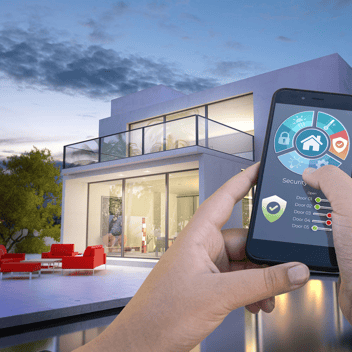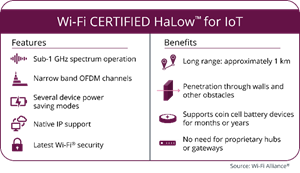SMART HOME DEVICES ON A HALOW NETWORK
Newracom
Smart Home Devices Should have their own Network
 Let's take a look at how Wi-FI 6 and Wi-Fi HaLow complement each other in the smart home environment. To learn more about how Wi-Fi HaLow could be used in the smart home check out our smart home article.
Let's take a look at how Wi-FI 6 and Wi-Fi HaLow complement each other in the smart home environment. To learn more about how Wi-Fi HaLow could be used in the smart home check out our smart home article.
Smart home devices are becoming more and more prevalent and in use by more and more households. According to Park Associates households now have an average of 16 connected devices. As these devices and the manufacturers of smart home devices expand, the security risk increases. The FBI recommends that your smart home devices be on a separate network for better security. To show how vulnerable smart homes can be, Which, a UK consumer champion and not-for-profit organization, simulated and monitored a smart home network in 2021 and at one point found they reached 14 hacking attempts an hour.
The other factor is that these smart devices can share data with their manufacturers and third parties. Part of the service agreement terms we all gloss over can include data collection on how the devices are used. Data collection is a big business. While not always nefarious, another risk factor for your personal information making it out in the world. It is in best practice to keep your personal data away from smart home manufacturers.
Having a separate network for your IoT devices helps avoid compromising access to your personal data on your computer or laptop. This separation should become a standard security practice as the number of smart homes increases.
Signal Where You Need It
The biggest advantage 802.11ah HaLow has over Wi-Fi 6 is range and penetration. Wi-Fi HaLow boasts a range of over one kilometer, and due to its use of a sub GHz frequency can penetrate walls and barriers much better. This means that your smart drier and washer in the garage or far-off laundry room are still within the bounds of a Wi-Fi HaLow network. Second or third stories can be reached from a single access point without issue.
Low Power Features
Both Wi-Fi 6 and Wi-Fi HaLow employ low power features to enable long battery life, making them ideal for use for smart devices operated by battery. However, due to the longer range of HaLow, devices that might be placed at the edge of a Wi-Fi 6 network would see longer battery life for HaLow. Devices at the edge of a network will have a higher data error rate, increasing the length of transmit times and draining the battery faster.
Number of Client Devices
 Wi-Fi HaLow can support over 8000 client devices from a single access point. Look how Wi-Fi HaLow can communicate with over 1000 devices with ease in our video demonstration. The number of smart devices in the home is growing. This showcases the importance of getting these devices on their own unshared frequency to avoid any contention. As more devices are added to the network this will be a growing area of importance.
Wi-Fi HaLow can support over 8000 client devices from a single access point. Look how Wi-Fi HaLow can communicate with over 1000 devices with ease in our video demonstration. The number of smart devices in the home is growing. This showcases the importance of getting these devices on their own unshared frequency to avoid any contention. As more devices are added to the network this will be a growing area of importance.
Strong Network Security
Your home network is only as safe as your weakest link, so having robust, continually updated network security is key to protecting the home network. Both Wi-Fi 6 and Wi-Fi HaLow use WPA3 security. WPA3 is mandated for all Wi-Fi Alliance-certified devices. This means both networks would use the latest security methods, keeping your home safe and secure. The WPA3 security standard is developed and maintained by the Wi-Fi Alliance.
Data Speed
Wi-Fi 6 features high-speed connections, with speeds of up to a blazing fast 9.6 Gbps, is the perfect application for personal computers, laptops, and streaming television needs. Wi-Fi HaLow data speed is limited by comparison, but it is fast enough to support HD video from doorbell cameras or outside security cameras. Wi-Fi 6 may not have to range to be able to reach outside the house or the signal penetration capabilities to make it through the walls. This makes an easy separation between high-speed applications on one network and your IoT smart devices on another network.
 A look at the ideal future
A look at the ideal future
To create the most secure yet functional smart home, IoT devices will be deployed on their own network, and devices with personal information like credit cards, and financial and medical records will be on their own information. This will hopefully all be built into a single router that is smart enough to help consumers protect themselves seamlessly.
The internet of things can help create an amazing, automated future that reacts to people's wants and needs. Utilizing HaLow, a wireless connectivity standard built with IoT in mind, with the security and robustness of the 802.11 Wi-Fi protocols is a very practical solution towards achieving this dream.



